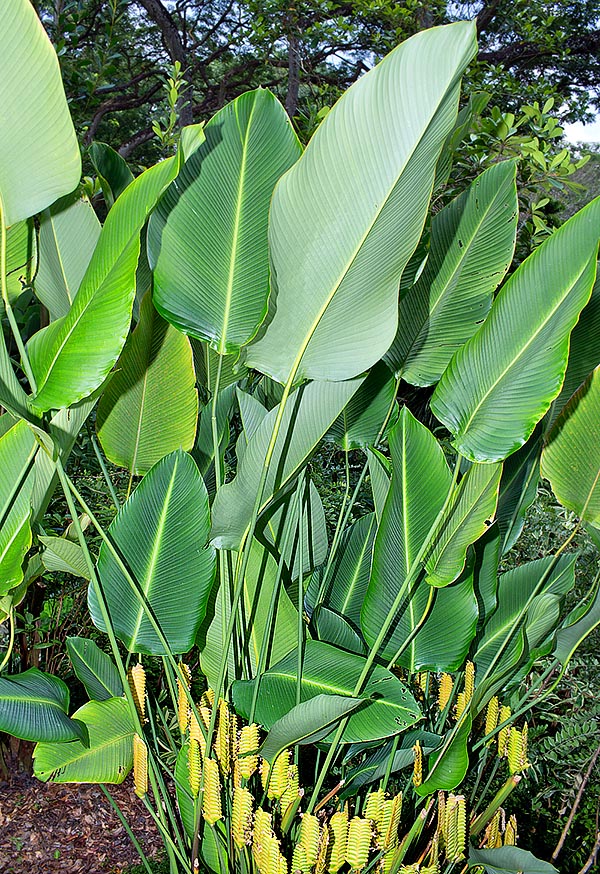Family : Marantaceae

Text © Pietro Puccio

English translation by Mario Beltramini

The Calathea crotalifera is native to Belize, Bolivia, Brazil, Colombia, Costa Rica, Ecuador, Guatemala, Honduras, Mexico, Nicaragua, Panama, Peru and Venezuela where it lives in the forests along water ways and at the edges of humid swampy zones, from the sea level up to about 1600 m of altitude © G. Mazza
The species is native to Belize, Bolivia, Brazil (Acre, Amazonas, Amapá, Pará, Roraima, Rondônia and Tocantins), Colombia, Costa Rica, Ecuador, Guatemala, Honduras, Mexico (Campeche, Chiapas, Quintana Roo, Tabasco and Yucatán), Nicaragua, Panama, Peru and Venezuela where it lives in the humid forests along the water streams and at the margins of swampy areas, from the sea level up to about 1600 m of altitude.
The name of the genus comes from the Greek “κάλαθος” (calathos) = basket, of not clear reference; the name of the species is the combination of the Latin substantive “crotalum” = rattlesnake, castanet, and of the verbum “fero” = to carry, with reference to the shape of the inflorescence.
Common names: rattlesnake plant, rattle shaker, rattlesnake ginger, yellow rattleshaker (English); serpent à sonnette (French); caetê-guizo-de-cascavel, cascavel (Portuguese-Brazil); bijagua, bijagüillo, cascabel, hoja blanca, hoja de sal, hoja de to verde (Spanish); Klappers- chlangenpflanze (German).
The Calathea crotalifera S.Watson (1889) is a perennial, evergreen, rhizomatous herbaceous species, forming 1,5-3 m tall dense tufts.
The leaves, on a 0,6-1 m long petiole, are alternate, basal, but one, oval to oblong-elliptic with apex brusquely pointed, 04-1 m long and 15-50 cm broad, of glossy intense green colour above, pale green below. Inflorescences, on a 20-30 cm long peduncle, emerging from the foliar sheath, erect, 15-25 cm long and 5-7 cm broad, formed by 16-40 coriaceous bracts strictly imbricate, disticous, almost horizontal, about 3 cm long, of greenish yellow colour.
The bracts subtend the tubular flowers of yellowish white colour with oblong sepals, about 1,6 cm long, and corolla, about 3 cm long, with 3 ovate-lanceolate pointed lobes; the flowers are pollinated by the bees. The fruits are ovoid capsules about 1,2 cm long containing 3 dark blue seeds with whitish fleshy aril.
It reproduces by seed in organic loam with addition of coarse siliceous sand per a 30%, maintained humid at the temperature of 24-26 °C, with germination times of 4-8 weeks, and easily, by division of rhizomes.

The Calathea crotalifera can also form, in the tropical countries, even 3 m tall tufts with 25 cm inflorescences and 16-40 greenish yellow bracts, strictly imbricate, disticous and almost horizontal. White, green, orange and also red horticultural forms exist nowadays. The tiny protruding yellowish flowers are pollinated by bees © Giuseppe Mazza
It requires a soil rich of organic substance, draining, maintained constantly humid. It adapts to the cultivation in capacious pots to be sheltered during the coldest months in luminous ambient, but far from the direct sun light, where the climate does not allow the continuous permanence in open air, utilizing an organic substratum with addition of coarse siliceous sand, perlite or other inerts, for improving the drainage, with lowest winter temperatures not under the 16 °C.
The waterings must be regular in summer but without stagnations, more spaced in winter, allowing the upper layer of the loam to dry up slightly before giving water again, and the fertilizations, in spring summer, done with balanced products with microelements. In presence of dry air it is necessary to frequently nebulize with non calcareous water to avoid unaesthetic spots on the leaves.
They have selected varieties with bracts of various colours, white, green, orange and red. The cut inflorescences, long-lasting, about 10 days, are utilized in the floral compositions.
Synonyms: Calathea insignis Petersen (1890); Phyllodes insigne (Petersen) Kuntze (1891); Phyllodes insignis (Petersen) Kuntze (1891); Calathea insignis Petersen ex Eggers (1893); Calathea sclerobractea K.Schum. (1902); Calathea quadratispica Woodson (1939).
